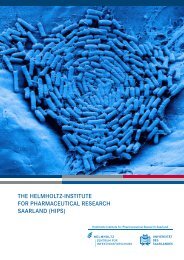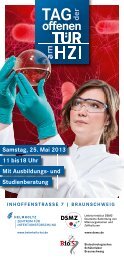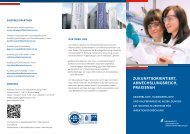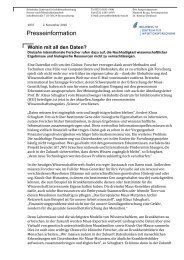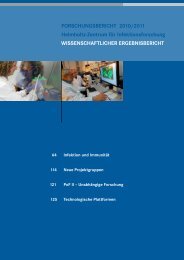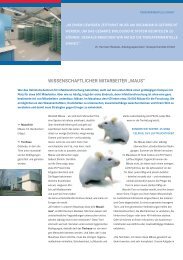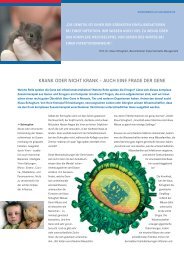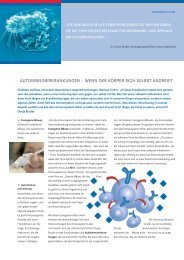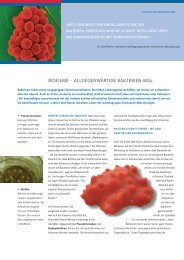Research Report 2010 2011 - Helmholtz-Zentrum für ...
Research Report 2010 2011 - Helmholtz-Zentrum für ...
Research Report 2010 2011 - Helmholtz-Zentrum für ...
You also want an ePaper? Increase the reach of your titles
YUMPU automatically turns print PDFs into web optimized ePapers that Google loves.
SCIENTIFIC REPORTS | Infection and Immunity | Microbial Pathogenesis 69<br />
01.1 Structural Analysis of Virulence Factors<br />
PROJECT LEADER | Prof. Dr. Dirk Heinz | Department of Molecular Structural Biology | dih@helmholtz-hzi.de<br />
PROJECT MEMBERS | Davide Ferraris | Thomas Heidler | Dr. Christian Kambach | Dr. Björn Klink |<br />
Dr. Jörn Krauße | Dr. Anja Menzel | Nick Quade | Dr. Stefan Schmelz | Ulrich Wiesand<br />
Pathogenic bacteria use an arsenal of virulence factors to<br />
breach natural host barriers, circumvent or block defense<br />
mechanisms or reprogramme host molecular processes<br />
for their own benefit. As most of these bacterial factors are<br />
missing in the host cell, they represent potential targets for<br />
novel antibiotics. The aim of this project is to gain a precise<br />
understanding of pathogen-host interactions during infection<br />
by X-ray crystallographic structural analysis of microbial<br />
virulence proteins in complex with their host target proteins.<br />
Listeria InlB activates the human receptor tyrosine kinase<br />
Met through dimerization L. monocytogenes is a harmful<br />
food pathogen which can cause listeriosis, a systemic disease<br />
with high mortality rates in neonates, the elderly and other<br />
immuno-compromized individuals. The unique capability of<br />
the bacterium to breach several important host-cell barriers<br />
critically depends on two invasins, internalin A and B (InlB),<br />
located at the bacterial surface. InlB interacts with the receptor<br />
tyrosine kinase Met, leading to bacterial uptake. Met<br />
is the receptor for hepatocyte growth factor (HGF), making<br />
it a key player in cell growth, cell migration, wound healing<br />
and cancer metastasis. Growth factor-mediated receptor<br />
activation typically involves dimerization of the receptor by<br />
the ligand, in this case as InlB2/Met2. In 2007, we determined<br />
the crystal structure of the InlB/Met complex. Like in<br />
the InlB structure, the complex displays a head-to-tail InlB<br />
dimer interface leading to a Met/InlB/InlB/Met-arrangement<br />
compatible with Met function, tyrosine kinase cross-phosphorylation<br />
and receptor activation. To confirm the putative<br />
role of InlB-mediated dimerization for Met activation, we<br />
crosslinked InlB by two symmetrical inter-InlB disulfide<br />
bridges like in the InlB dimers (Fig. 1). Strikingly, this covalent<br />
InlB dimer leads to strong Met activation outperforming<br />
even HGF. Conversely, weakening the InlB dimer interface<br />
by introducing opposing positively charged amino acids<br />
completely abrogates Met signalling.<br />
A new class of bacterial guanine nucleotide exchange<br />
factors for human GTPases Actin cytoskeleton remodelling<br />
is essential for cell division, motility or cell-cell communication.<br />
It is tightly regulated by multiple signalling pathways<br />
employing many different actin-binding proteins. Most if not<br />
all pathways converge on small Rho family GTPases which<br />
act as switches inducing different actin-filament structures.<br />
GTPase signalling requires control by guanine nucleotide exchange<br />
factors (GEFs). Rho-GTPases are key targets of pathogens<br />
modifying cell signalling or actin remodelling for their<br />
own needs. Pathogens frequently bypass or activate Rho-<br />
GTPase pathways by producing virulence factors mimicking<br />
Rho-interacting proteins. This allows them to induce tight<br />
adherence to or entry into host cells. Shigella flexneri IpgB1<br />
and IpgB2 and Map from pathogenic E. coli are prototypic<br />
members of an intriguing novel family of bacterial effectors.<br />
These were originally classified as GTPase mimics, despite<br />
the lack of sequence homology or GTP binding. They induce<br />
filopodia (Map) or lamellipodia and stress fibers indicative<br />
of Rac1 and RhoA activity for IpgB1 and IpgB2, respectively.<br />
We solved the crystal structures of IpgB2 and its complex<br />
with human RhoA (Fig. 2), unambiguously identifying IpgB2<br />
as a bacterial RhoA-GEF not as a functional mimic. Structures<br />
of the complex in various nucleotide bound states revealed<br />
the molecular mechanism of GDP release, an essential<br />
prerequisite for GTP binding.<br />
Fig. 2. Structure of the complex between IpgB2 (blue) and<br />
RhoA (brown). GDP is shown in orange and the GDP-coordinating<br />
Mg 2+ is a yellow sphere. Red spheres are water molecules<br />
coordinating Mg 2+ . The switch I region of RhoA is shown as a<br />
yellow loop, switch II in green. The „catalytic loop“ of IpgB2 is<br />
shown in red.<br />
Fig. 1. Structure of the InlB dimer (blue) covalently cross-linked<br />
by the introduction of two disulfide bridges (yellow sticks,<br />
with electron density).<br />
Ferraris, D. M., Gherardi, E., Di, Y., Heinz, D. W. & Niemann, H. N. (<strong>2010</strong>). Ligand-mediated<br />
dimerization of the Met receptor tyrosine kinase by the bacterial invasion protein<br />
InlB. Journal of Molecular Biology 395, 522-532.<br />
Klink, B. U., Barden, S., Heidler, T. V., Borchers, C., Ladwein, M., Stradal, T. E., Rottner,<br />
K. & Heinz, D. W. (<strong>2010</strong>). Structure of Shigella IpgB2 in complex with human RhoA: Implications<br />
for the mechanism of bacterial GEF-mimicry. Journal of Biological Chemistry<br />
285, 17197-17208.



